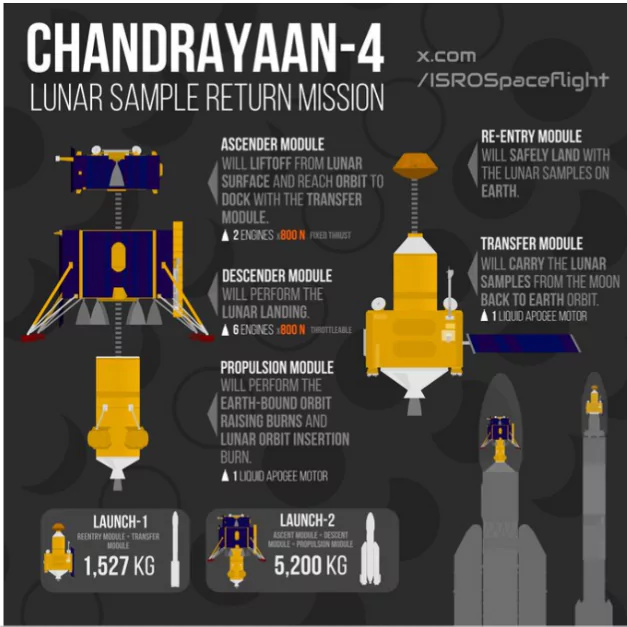Chandrayaan-4: India’s Next Leap in Lunar Exploration
Why in the news?
India announces Chandrayaan-4, aiming to collect lunar samples and test docking technology, advancing its goals for future manned missions and a space station by 2035.
Highlights of Chandrayaan-4:
- Mission Type: India’s next significant lunar mission following Chandrayaan-3.
- Budget: ₹2,104.06 crore ($253 million).
- Objectives: To collect lunar samples for return to Earth, enhancing knowledge for future manned missions.
Key Features
- Sample Collection: Aims to gather and return lunar materials, crucial for understanding the Moon’s geology.
- Docking Technology: Will test docking and undocking procedures in lunar orbit, essential for future space exploration.
Future Aspirations
- Timeline: Scheduled for completion within 36 months.
- Broader Goals: Part of India’s ambitious space plans, including establishing a space station by 2035 and aiming for a manned lunar landing by 2040.
Facts about the Chandrayaan-4 Mission:
- Management: ISRO will oversee the mission, including spacecraft and launch vehicle development.
- Timeline: Expected completion within 36 months of approval.
Rover Details:
- Weight: Planned rover will weigh 350 kg, significantly heavier than Chandrayaan-3’s 30 kg rover.
- Exploration Area: Rover will cover an area of 1 km x 1 km, larger than Chandrayaan-3’s 500 m x 500 m.
Landing Precision
- Landing Target: Aims for a precise landing on the Moon’s rim, focusing on unexplored areas.
Objectives:
- Technology Demonstration:
- Docking/undocking techniques for lunar and Earth missions.
- Achieving safe lunar landing and return to Earth.
- Collecting and analysing lunar samples.
- Foundational Technologies: Establishing capabilities for a future manned lunar mission planned for
- Mission Components:
- Reentry Module (RM)
- Transfer Module (TM)
- Lander Module (LM)
- Ascender Module (AM)
- Propulsion Module (PM)
- Launch Vehicles:
- PSLV for RM and TM.
- LVM-3 for LM, AM, and PM.
Significance
- Builds on Chandrayaan-3 success, expanding India’s capabilities in space technology and preparing for future lunar explorations.
ISRO’s Future Plans for Space:
Bhartiya Antariksh Station (BAS):
- First module launch planned for
- Will conduct experiments using robots.
Inflatable Habitat Module:
- Designed for long-duration stays by astronauts in low Earth orbit.
Satellite Refuelling Technology:
- Exploring technologies for refuelling satellites in space.
Next Generation Launch Vehicle (NGVL):
- Capacity to carry 16 to 25 tons to low Earth orbit.
Space Docking Experiment (SPADEX):
- Demonstrates autonomous docking capabilities.
- Scheduled for launch in Q3 2024.
Lunar Polar Exploration Mission (LuPEX):
- Collaboration with JAXA to explore lunar south pole’s shaded areas.
- Aims to gather data on water presence on the Moon.
Sources Referred:
PIB, The Hindu, Indian Express, Hindustan Times




